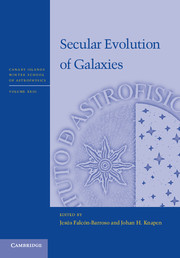Book contents
- Frontmatter
- Contents
- List of contributors
- Participants
- Preface
- Acknowledgments
- Secular evolution in disk galaxies
- Galaxy morphology
- Dynamics of secular evolution
- Bars and secular evolution in disk galaxies: Theoretical input
- Stellar populations
- Star formation rate indicators
- The evolving interstellar medium
- Evolution of star formation and gas
- Cosmological evolution of galaxies
- References
Dynamics of secular evolution
Published online by Cambridge University Press: 05 September 2013
- Frontmatter
- Contents
- List of contributors
- Participants
- Preface
- Acknowledgments
- Secular evolution in disk galaxies
- Galaxy morphology
- Dynamics of secular evolution
- Bars and secular evolution in disk galaxies: Theoretical input
- Stellar populations
- Star formation rate indicators
- The evolving interstellar medium
- Evolution of star formation and gas
- Cosmological evolution of galaxies
- References
Summary
Abstract
The material in this article was presented in five hours of lectures to the 2011 Canary Islands Winter School. The School's theme was ‘Secular Evolution of Galaxies’ and my task was to present the underlying stellar-dynamical theory. Other lecturers were speaking on the role of bars and chemical evolution, so these topics are avoided here. The material starts with an account of the connections between isolating integrals, quasiperiodicity and angle-action variables – these variables played a prominent and unifying role throughout the lectures. This leads on to the phenomenon of resonant trapping and how this can lead to chaos in cuspy potentials and phase-space mixing in slowly evolving potentials. Surfaces of section and frequency analysis are introduced as diagnostics of phase-space structure. Real galactic potentials include a fluctuating part that drives the system towards unattainable thermal equilibrium. Two-body encounters are only one source of fluctuations, and all fluctuations will drive similar evolution. The orbit-averaged Fokker-Planck equation is derived, as are relations that hold between the second-order diffusion coefficients and both the power spectrum of the fluctuations and the first-order diffusion coefficients. From the observed heating of the solar neighbourhood we show that the second-order diffusion coefficients must scale as ˜ J1/2. We show that periodic spiral structure shifts angular momentum outwards, heating at the Lindblad resonances and mixing at corotation. The equation that would yield the normal modes of a stellar disk is first derived and then used to discuss the propagation of tightly wound spiral waves.
- Type
- Chapter
- Information
- Secular Evolution of Galaxies , pp. 259 - 304Publisher: Cambridge University PressPrint publication year: 2013
References
- 6
- Cited by

